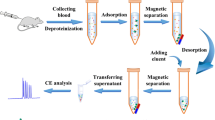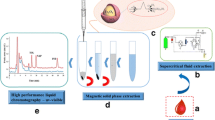Abstract
The authors describe the preparation of copper-doped magnetic microspheres (Cu-Fe3O4) by a solvothermal method. Due to their good magnetic property and high affinity for compounds containing an imidazole moiety (containing N-H), they are excellent adsorbents for such compounds as tested by eighteen compounds. Specifically, a method has been developed for magnetic solid-phase extraction (MSPE) of theophylline (TP) from plasma. The method enables selective enrichment of TP over many potential interferents that can occur in plasma. Following elution with alkaline methanol, TP was quantified by HPLC-UV at a detection wavelength of 272 nm. Under the optimized conditions, a linear response is found for the 0.02 to 20 μg·mL−1 concentration range, and the limit of detection is as low as 3 ng·mL−1. Recoveries from spiked samples range from 91.2 to 100.4%, and the repeatabilities are between 2.9 and 12% (for n = 6). The method was successfully applied to the determination of TP in rabbit and rat plasma.

Copper-doped magnetic microspheres are described that show good magnetic property and high affinity for compounds containing an imidazole moiety (containing an N-H group). They were successfully applied to the selective extraction of theophylline in plasma.




Similar content being viewed by others
References
Bates F, Valle MD (2015) Voltammetric sensor for theophylline using sol-gel immobilized molecularly imprinted polymer particles. Microchim Acta 182:933–942
Li MJ, Zhou JY, Gu X, Wang Y, Huang XJ, Yan C (2009) Quantitative capillary electrophoresis and its application in analysis of alkaloids in tea, coffee, coca cola, and theophylline tablets. J Sep Sci 32:267–274
Liu P, Liu RY, Guan GJ, Jiang CL, Wang SH, Zhang ZP (2011) Surface-enhanced raman scattering sensor for theophylline determination by molecular imprinting on silver nanoparticles. Analyst 136:4152–4158
Xiao GQ, Wen RM, Wei DM, Wu D (2016) A novel hyper-cross-linked polymeric adsorbent with high microporous surface area and its adsorption to theophylline from aqueous solution. Microporous Mesoporous Mater 228:168–173
Kan XW, Liu TT, Zhou H, Li C, Fang B (2010) Molecular imprinting polymer electrosensor based on gold nanoparticles for theophylline recognition and determination. Microchim Acta 171:423–429
Yan F, Liu ZY, Chen JL, Sun XY, Li XJ, Su MX, Li B, Di B (2014) Nanoscale zeolitic imidazolate framework-8 as a selective adsorbent for theophylline over caffeine and diprophylline. RSC Adv 4:33047–33054
Ferapontova EE, Olsen EM, Gothelf KV (2008) An RNA aptamer-based electrochemical biosensor for detection of theophylline in serum. J Am Chem Soc 130:4256–4258
Mullett WM, Lai EPC (1998) Determination of theophylline in serum by molecularly imprinted solid-phase extraction with pulsed elution. Anal Chem 70:3636–3641
Saka K, Uemura K, Shintani-Ishida K, Yoshida KI (2007) Acetic acid improves the sensitivity of theophylline analysis by gas chromatography-mass spectrometry. J Chromatogr B 846:240–244
Huck CW, Guggenbichler W, Bonn GK (2005) Analysis of caffeine, theobromine and theophylline in coffee by near infrared spectroscopy (NIRS) compared to high-performance liquid chromatography (HPLC) coupled to mass spectrometry. Anal Chim Acta 538:195–203
Chovelon B, Durand G, Dausse E, Toulmé JJ, Faure P, Peyrin E, Ravelet C (2016) ELAKCA: enzyme-linked aptamer kissing complex assay as a small molecule sensing platform. Anal Chem 88:2570–2575
Wang Y, Wu T, Bi CY (2016) Simultaneous determination of acetaminophen, theophylline and caffeine using a glassy carbon disk electrode modified with a composite consisting of poly(Alizarin Violet 3B), multiwalled carbon nanotubes and graphene. Microchim Acta 183:731–739
Xu JH, Wang YZ, Hu SS (2017) Nanocomposites of graphene and graphene oxides: synthesis, molecular functionalization and application in electrochemical sensors and biosensors. A review. Microchim Acta 184:1–44
Ling K, Jiang HY, Li Y, Tao XJ, Qiu C, Li FR (2016) A self-assembling RNA aptamer-based graphene oxide sensor for the turn-on detection of theophylline in serum. Biosens Bioelectron 86:8–13
Ahn JK, Park KS, Won BY, Park HG (2015) A novel electrochemical method to detect theophylline utilizing silver ions captured within abasic site-incorporated duplex DNA. Biosens Bioelectron 67:590–594
Cheng T, Zhang Y, Liu XY, Zhang XY, Zhang HX (2017) Surfactant assisted enrichment of nucleosides by using a sorbent consisting of magnetic polysulfone capsules and mesoporous silica nanoparticles modified with phenylboronic acid. Microchim Acta 184:271–278
Zhu QF, Ma C, Chen HX, Wu YQ, Huang JL (2014) A molecular imprint-coated stirrer bar for selective extraction of caffeine, theobromine and theophylline. Microchim Acta 181:303–311
Khorrami AR, Rashidpur A (2009) Design of a new cartridge for selective solid phase extraction using molecularly imprinted polymers: selective extraction of theophylline from human serum samples. Biosens Bioelectron 25:647–651
Tang WY, Li GZ, Row KH, Zhu T (2016) Preparation of hybrid molecularly imprinted polymer with double-templates for rapid simultaneous purification of theophylline and chlorogenic acid in green tea. Talanta 152:1–8
Bi WT, Tian ML, Row KH (2012) Facile synthesis and application of poly(ionic liquid)-bonded silica hybrid materials. Analyst 137:2017–2020
Sereshti H, Khosraviani M, Samadi S, Amini-Fazl MS (2014) Simultaneous determination of theophylline, theobromine and caffeine in different tea beverages by graphene-oxide based ultrasonic-assisted dispersive micro solid-phase extraction combined with HPLC-UV. RSC Adv 4:47114–47120
Bian J, Xue Y, Yao K, Gu X, Yan C, Wang Y (2014) Solid-phase extraction approach for phospholipids profiling by titania-coated silica microspheres prior to reversed-phase liquid chromatography-evaporative light scattering detection and tandem mass spectrometry analysis. Talanta 123:233–240
Wang ST, Huang W, Lu W, Yuan BF, Feng YQ (2013) TiO2-based solid phase extraction strategy for highly effective elimination of normal ribonucleosides before detection of 2′-deoxynucleosides/low-abundance 2′-O-modified ribonucleosides. Anal Chem 85:10512–10518
Wu Q, Wu DP, Guan YF (2014) Hybrid titania-zirconia nanoparticles coated adsorbent for highly selective capture of nucleosides from human urine in physiological condition. Anal Chem 86:10122–10130
Wang ST, Huang W, Deng YF, Gao Q, Yuan BF, Feng YQ (2014) “Old” metal oxide affinity chromatography as “novel” strategy for specific capture of cis-diol-containing compounds. J Chromatogr A 1361:100–107
Li HF, Xie T, Ye LL, Wang YW, Xie CG (2017) Core-shell magnetic molecularly imprinted polymer nanoparticles for the extraction of triazophos residues from vegetables. Microchim Acta 184:1011–1019
Fan H, Chen PH, Wang CZ, Wei YM (2016) Zirconium-doped magnetic microspheres for the selective enrichment of cis-diol-containing ribonucleosides. J Chromatogr A 1448:20–31
Wang T, Yang WC, Song TT, Li CF, Zhang LY, Wang HY, Chai LY (2015) Cu doped Fe3O4 magnetic adsorbent for arsenic: synthesis, property, and sorption application. RSC Adv 5:50011–50018
Wang W, He MF, Wang CZ, Wei YM (2015) Enhanced binding capacity of boronate affinity adsorbent via surface modification of silica by combination of atom transfer radical polymerization and chain-end functionalization for high-efficiency enrichment of cis-diol molecules. Anal Chim Acta 886:66–74
Zhang WM, Lin MX, Tong P, Lu QM, Zhang L (2016) Ferrite nanospheres-based magnetic solid-phase extraction for determination of domoic acid in seawater samples using high-performance liquid chromatography with tandem mass spectrometry. J Chromatogr A 1443:54–61
Oshima T, Oshima C, Baba Y (2015) Selective extraction of histidine derivatives by metal affinity with a copper(II)-chelating ligand complex in an aqueous two-phase system. J Chromatogr B 990:73–79
Tatikonda R, Kalenius E, Haukka M (2016) Synthesis and characterization of zwitterionic Zn(II) and Cu(II) coordination compounds with ring-substituted 2,2′-biimidazole derivatives. Inorg Chim Acta 453:298–304
González O, Blanco ME, Iriarte G, Bartolomé L, Maguregui MI, Alonso RM (2014) Bioanalytical chromatographic method validation according to current regulations, with a special focus on the non-well defined parameters limit of quantification, robustness and matrix effect. J Chromatogr A 1353:10–27
Ardjomand-Woelkart K, Kollroser M, Li L, Derendorf H, Butterweck V, Bauer R (2011) Development and validation of a LC-MS/MS method based on a new 96-well hybrid-SPE™-precipitation technique for quantification of CYP450 substrates/metabolites in rat plasma. Anal Bioanal Chem 400:2371–2381
Dai H, Xiao DL, He H, Li H, Yuan DH, Zhang C (2015) Synthesis and analytical applications of molecularly imprinted polymers on the surface of carbon nanotubes: a review. Microchim Acta 182:893–908
Acknowledgements
This work was supported by the National Natural Science Foundation of China (No. 21475104, 21775121 and 21575114) and the Industry Development Project by the Science and Technology Department of Shaanxi Province (No. 2016GY-214).
Author information
Authors and Affiliations
Corresponding author
Ethics declarations
The authors declare that they have no competing interests.
Electronic supplementary material
ESM 1
(DOCX 2262 kb)
Rights and permissions
About this article
Cite this article
Chen, P., Shen, J., Wang, C. et al. Selective extraction of theophylline from plasma by copper-doped magnetic microspheres prior to its quantification by HPLC. Microchim Acta 185, 113 (2018). https://doi.org/10.1007/s00604-017-2667-4
Received:
Accepted:
Published:
DOI: https://doi.org/10.1007/s00604-017-2667-4




